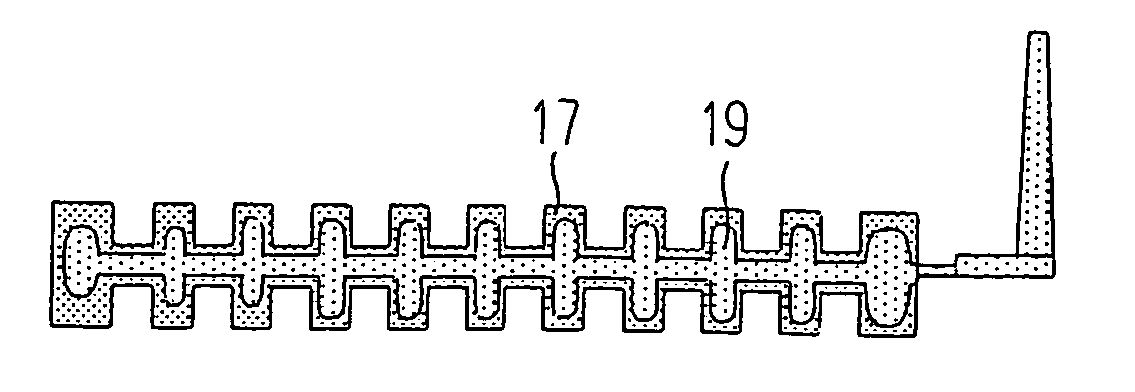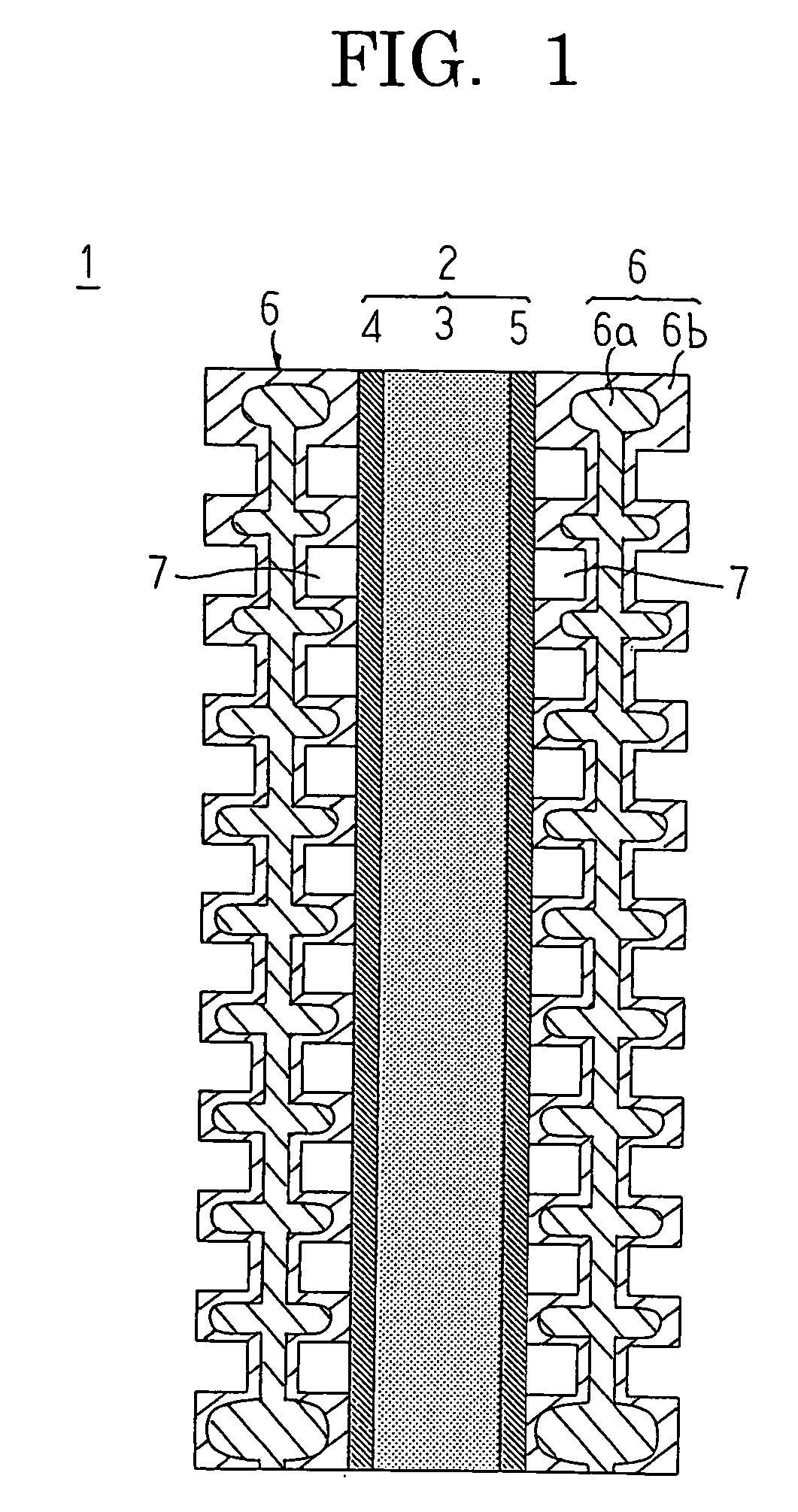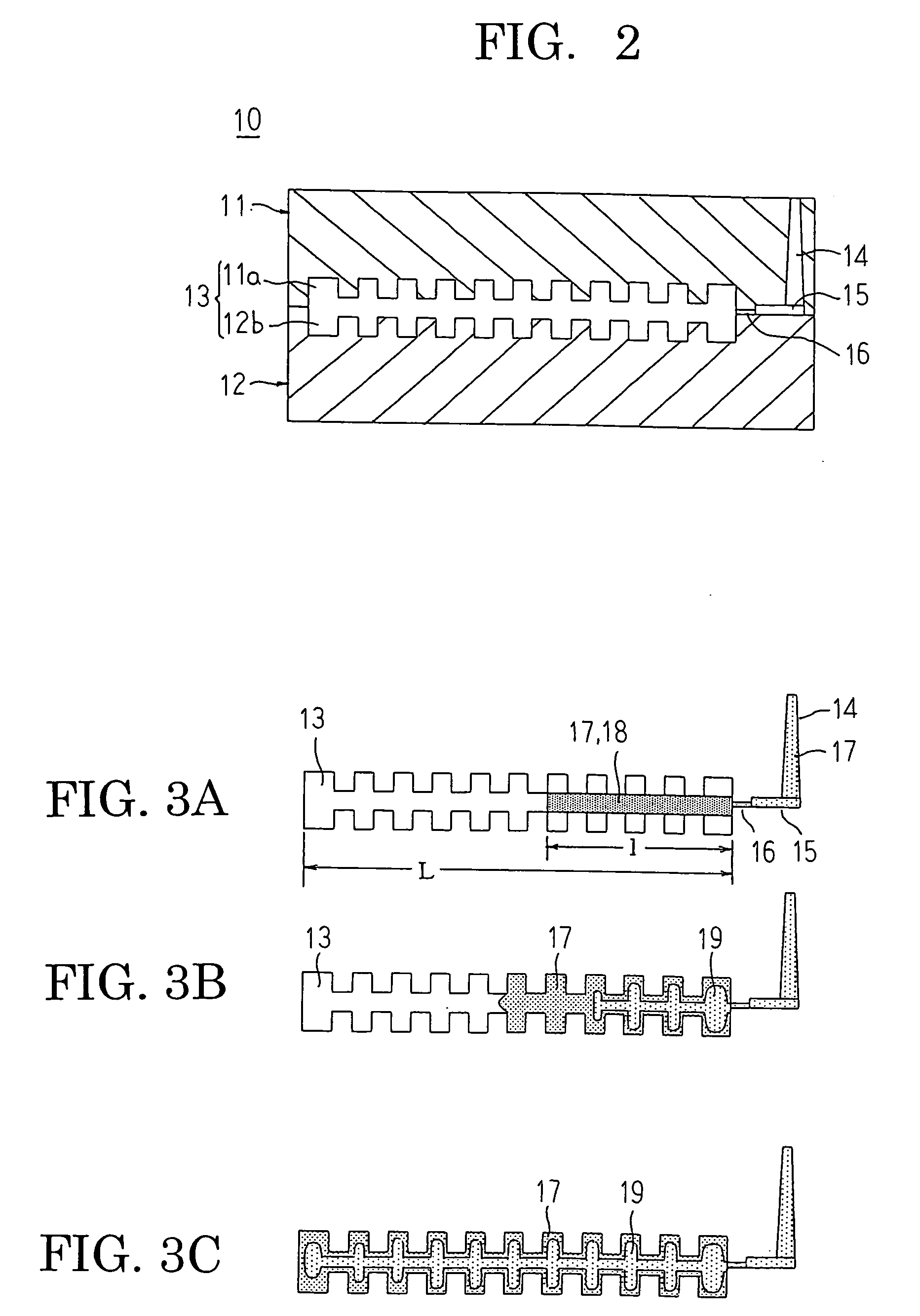Fuel cell separator and a method for manufacturing the same
a technology of fuel cell separator and separator body, which is applied in the direction of cell components, final product manufacturing, sustainable manufacturing/processing, etc., can solve the problems of inability to perform injection molding of resin, limitation of the electrical resistance reduction of the separator, and inability to obtain uniform electrical resistance over the entire outer layer. , to achieve the effect of low electrical resistance and low cos
- Summary
- Abstract
- Description
- Claims
- Application Information
AI Technical Summary
Benefits of technology
Problems solved by technology
Method used
Image
Examples
embodiment 1
[0025]FIG. 1 is a cross sectional view that schematically illustrates a single cell constituting a solid polymer type fuel cell according to a first embodiment of the present invention.
[0026] In FIG. 1, the single cell, generally designated at reference numeral 1, includes a combined electrode and membrane member 2, and a pair of separators 6 arranged so as to clamp or sandwich the combined electrode and membrane member 2 from its opposite sides.
[0027] The combined electrode and membrane member 2 includes a pair of porous electrodes 4, 5 and an electrolyte membrane 3, and is arranged in such a manner that the porous electrodes 4, 5 each of a rectangular and planar configuration respectively face the opposite sides of the electrolyte membrane 3 of a similarly rectangular and planar configuration so as to be integrally combined therewith. The porous electrodes 4, 5 are formed of a porous medium such as carbon paper, carbon cloth, etc., and are each formed into a rectangular shape of...
example 1
[0055] In this first example, polyphenylene sulfide resin was used as a base resin, and carbon particles were used as electrically conductive particles. Carbon particles were added to the polyphenylene sulfide resin at 70 wt % so that a first resin was prepared and adjusted so as to have a melt shear viscosity of 2×106 Pa.sec at a resin temperature of 290° C. at a shear rate of 1,000 sec−1. In addition, carbon particles were added to the polyphenylene sulfide resin at 65 wt % so that a second resin was prepared and adjusted so as to have a melt shear viscosity of 5×103 Pa.sec at a resin temperature of 290° C. at a shear rate of 1,000 sec−1.
[0056] Subsequently, the first resin thus prepared was press molded to provide a resin block. The resin block was constructed to be of a rectangular and planar configuration having substantially the same thickness as the minimum thickness or distance of a space or cavity in a mold (i.e., thickness between opposed bottoms of gas passages in a sepa...
example 2
[0061] In this second example, polyphenylene sulfide resin was used as a base resin, and carbon particles were used as electrically conductive particles. Carbon particles were added to the polyphenylene sulfide resin at 60 wt % so that a first resin was prepared and adjusted so as to have a melt shear viscosity of 5×103 Pa.sec at a resin temperature of 290° C. at a shear rate of 1,000 sec−1. In addition, carbon particles were added to the polyphenylene sulfide resin at 50 wt % so that a second resin was prepared and adjusted so as to have a melt shear viscosity of 3×102 Pa.sec at a resin temperature of 290° C. at a shear rate of 1,000 sec−1.
[0062] Subsequently, the first resin thus prepared was press molded to provide a resin block. The resin block was constructed to be of a rectangular and planar configuration having substantially the same thickness as the minimum thickness or distance of a space or cavity in a mold (i.e., thickness between opposed bottoms of gas passages in a sep...
PUM
| Property | Measurement | Unit |
|---|---|---|
| melt shear viscosity | aaaaa | aaaaa |
| melt shear viscosity | aaaaa | aaaaa |
| melt shear viscosity | aaaaa | aaaaa |
Abstract
Description
Claims
Application Information
 Login to View More
Login to View More - R&D
- Intellectual Property
- Life Sciences
- Materials
- Tech Scout
- Unparalleled Data Quality
- Higher Quality Content
- 60% Fewer Hallucinations
Browse by: Latest US Patents, China's latest patents, Technical Efficacy Thesaurus, Application Domain, Technology Topic, Popular Technical Reports.
© 2025 PatSnap. All rights reserved.Legal|Privacy policy|Modern Slavery Act Transparency Statement|Sitemap|About US| Contact US: help@patsnap.com



